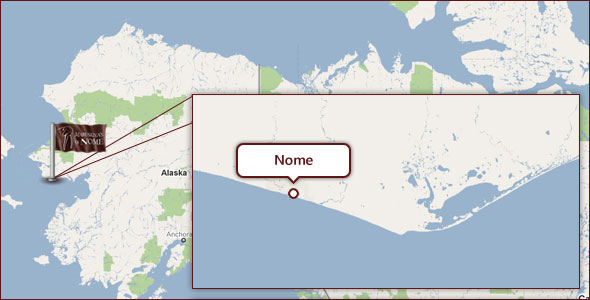
Situated on the southern side of the Seward Peninsula on the coast of the Bering Sea, Nome boasts a whopping population of about 3,500, making it quite the metropolis (at least by rural Alaskan standards!). As the hub of Northwest Alaska, Nome serves its residents and regional villages by offering important amenities and services, such as places to shop for food and supplies, meeting spaces for groups, organizations and corporations, as well as a large regional hospital.
History
Many historical accounts of Nome start with the discovery of gold by the "Three Lucky Swedes" in 1898. However, the Inupiat have hunted, fished, and gathered seasonally throughout the Seward Peninsula for thousands of years. In addition, a 2007 archaeological discovery found permanent Inupiaq dwellings in Nome that were carbon dated to about 1700 AD-- before contact with the first Russian explorers. This is the first evidence that shows that people lived in Nome year-round well before the discovery of gold.
After the discovery of gold in Anvil Creek in 1898, thousands of people flocked to Nome in search of riches. In response to the rising population, the city of Nome was incorporated in 1901. During the peak of the gold rush, Nome's population is estimated to have reached above 20,000, making it Alaska's most populous city at the time. By 1910 the rush for gold subsided and most of those who had come to make their fortune left, reducing Nome's population to about 2,500.
In 1925 Nome was hit with a diphtheria epidemic and with no way to deliver the needed antitoxin, mushers and their sled dogs were charged with the task. In what would become known as "The Great Race of Mercy", the mushers and their dogs traveled 674 miles in an astounding five and a half days from Nenana to Nome, delivering the life saving serum and saving countless lives in Nome and throughout the region. The trail that was used for this amazing feat reached from Seward to Nome, and before the time of regular winter air travel, it was the great thoroughfare of Alaska, used by dog teams to carry goods, mail, and people throughout the state. Of course, this was all made possible by the Alaska Native people, who had mastered the art of mushing dogs hundreds of years before. The trail is now known as the Iditarod Trail, and its significance to Alaskan history is commemorated each year with the Iditarod Sled Dog Race. The race begins in Anchorage and mushers from all over compete to become the first to have their dog teams pull their sled over 1,150 miles of rugged Alaskan terrain and reach the finish line in Nome. People travel to Nome from all over the world to share in the week of revelry and celebration that accompanies the mushers' finish of the race.
Nome Today
Today, Nome serves as the hub community for Northwest Alaska. People fly in to Nome for medical care, for government services, and to purchase food and other supplies. In the winter months, these daily flights are the only way for goods and residents to reach the surrounding villages. Although the gold rush days are long over, Nome's economy is also boosted by many small scale gold mining operations, as well as the large and somewhat controversial Rock Creek mine.
With a constant flow of people coming in from the surrounding villages, as well as miners, professionals, and adventurers who have come up from the rest of the United States, the community of Nome is a true melting pot. Residents include people from every nearby village, spanning Inupiaq, Siberian Yupik, and Yup'ik cultures, mixed in with the smorgasbord of ethnic backgrounds of the people from the "Lower 48" who have made Nome their home.
Nome is also home to King Island Inupiaq, although if asked many would say that home is still King Island. King Island was abandoned in the 1960s for a variety of reasons, such as better jobs and medical care in Nome. The condemning of the schoolhouse in the late sixties by the BIA (Bureau of Indian Affairs) dealt the final blow to King Island, forcing the last residents to leave for good in 1969. Most King Islanders now live in Nome, where they maintain a strong identity and rich culture.






